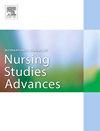Nurses’ challenges and strategies for safeguarding care quality and safety: A qualitative study on situated resilience
IF 3.1
Q1 NURSING
International Journal of Nursing Studies Advances
Pub Date : 2025-06-11
DOI:10.1016/j.ijnsa.2025.100365
引用次数: 0
Abstract
Background
Most healthcare delivery succeeds in safeguarding high-quality care and safety. This is largely due to the adaptive capacity and situated resilience work of healthcare professionals as nurses who keeps things on track. However, much of their situated resilience work in complex everyday practice remains hidden or is done behind the scenes.
Objective
To explore situated resilience in everyday nursing practice and shed light on the often invisible efforts of nurses as they manage immediate challenges and navigate complex processes to ensure care quality and safety.
Design
A qualitative design.
Setting(s)
The surgical and an ambulatory care team of an urban, 600-bed Dutch teaching hospital.
Participants
Nurses (N = 37), nurse practitioners (N = 2), managers (N = 5),
Methods
Data were collected through 80 hours of non-participant non-participant observations, three semi-structured interviews with nurses and one monodisciplinary (i.e. nurses) focus group. Thereafter, two multidisciplinary focus groups were conducted. Data were analysed using thematic analysis. The research protocol was approved by the ethical review board of Erasmus University Rotterdam under number ETH2122-0079.
Results
Nurses are dedicated providing the high-quality care that ensures patient safety. In daily practice they face challenges that require them to make changes to system standards. We identified three key triggers for change and emerging strategies to handle these triggers: 1) when standard risk assessment does not fit nursing practice, nurses a) seem to comply with the system, b) adopt an investigative, attentive approach. 2) when protocols and guidelines do not align with daily practices, nurses a) proactively identify potential and actual changes, b) find the "golden mean" through relational negotiation and patient advocacy. 3) when nurses and other healthcare professionals hold differing values on care quality and safety, nurses a) find allies, and b) applied various indirect means.
Conclusions
Our study reveals that situated resilience in nursing is not only a television series of actions to fix misalignments or to deal with unexpected change. It unfolds as a relational process in which nurses adapt their behaviour intuitively according to a patient’s unique situation, values, and interests. By balancing the individual patient’s needs and values with organizational systemic demands nurses exhibit situated resilience. By recognizing and supporting situated resilience practices, organizations not only enhance the quality of daily practice but also structurally strengthen their adaptive and resilient capacities. Further research into the role of nurses in system-level resilience and the impact of experience on resilience behaviour is needed.
Social media abstract
Nurses exhibit resilience by balancing patient’s needs with organizational systemic demands, and aligning differing values in a relational process @ijnsa2025
护士保障护理质量与安全的挑战与策略:情境弹性的质性研究
大多数医疗保健服务成功地保障了高质量的护理和安全。这在很大程度上是由于适应能力和位于弹性工作的医疗保健专业人员作为护士谁保持事情的轨道。然而,他们在复杂的日常实践中所做的大部分弹性工作仍然是隐藏的或在幕后完成的。目的探讨日常护理实践中的情境弹性,揭示护士在应对眼前挑战和应对复杂流程以确保护理质量和安全时往往无形的努力。设计:定性设计:环境:一所拥有600张床位的城市荷兰教学医院的外科和门诊护理团队。参与者:护士(N = 37)、执业护士(N = 2)、管理人员(N = 5)。方法通过80小时的非参与性非参与性观察、3次对护士的半结构化访谈和1次单学科(即护士)焦点小组收集数据。此后,进行了两个多学科焦点小组。采用专题分析对数据进行分析。研究方案由鹿特丹伊拉斯谟大学伦理审查委员会批准,编号为ETH2122-0079。结果护理人员致力于提供高质量的护理,确保患者的安全。在日常实践中,他们面临着需要对系统标准进行更改的挑战。我们确定了变革的三个关键触发因素和处理这些触发因素的新兴策略:1)当标准风险评估不适合护理实践时,护士a)似乎遵守该系统,b)采用调查,细心的方法。2)当协议和指南与日常实践不一致时,护士a)主动识别潜在和实际的变化,b)通过关系谈判和患者倡导找到“中庸之道”。3)当护士和其他医疗保健专业人员对护理质量和安全持有不同的价值观时,护士a)寻找盟友,b)采用各种间接手段。结论我们的研究表明,护理中的情境弹性不仅仅是一种固定错位或应对意外变化的一系列电视动作。它作为一个关系过程展开,护士根据病人的独特情况,价值观和兴趣直观地调整他们的行为。通过平衡个体患者的需求和价值与组织系统的需求护士表现出适应力。通过认识和支持适应力实践,组织不仅提高了日常实践的质量,而且从结构上加强了他们的适应性和适应力能力。需要进一步研究护士在系统级弹性中的作用以及经验对弹性行为的影响。社会媒体摘要护士通过平衡患者需求和组织系统需求,并在关系过程中调整不同的价值观来展示弹性@ijnsa2025
本文章由计算机程序翻译,如有差异,请以英文原文为准。
求助全文
约1分钟内获得全文
求助全文
来源期刊

International Journal of Nursing Studies Advances
Nursing-General Nursing
CiteScore
5.80
自引率
0.00%
发文量
45
审稿时长
81 days
 求助内容:
求助内容: 应助结果提醒方式:
应助结果提醒方式:


